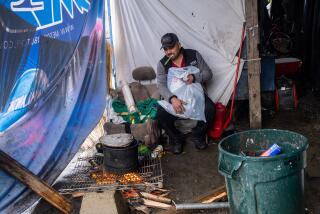Goal Is to Break the ‘Cycle of Homelessness’ : Job Training Offers More Than Work
- Share via
Charles S., dressed in jeans, a navy V-neck sweater and a Detroit Tigers baseball cap, sat at noon on Valentine’s Day in the middle of Plummer Park talking with two friends. He had just finished his four-hour shift as a maintenance worker for the city of West Hollywood. Lunch was on his mind.
“Sometimes I don’t get enough food so I go dumpster diving,” said Charles, who asked that his last name not be used. “Dumpster diving” is Charles’ term for digging through trash bins looking for food. “Sometimes you get lucky and find some bread,” he said.
‘Can’t Escape Cycle’
Charles is one of five workers employed by the city of West Hollywood in an innovative job-training program for the city’s homeless, begun on Jan. 30. The workers receive food and shelter and are paid $5 per hour for 20 hours of work each week. They also are paid the same rate for participating in 10 hours of job counseling each week.
There is no other program in the state like it, according to city officials and Norman Coppinger, social services coordinator of the California League of Cities. The city will employ the workers for up to 16 weeks and try to place them in jobs and permanent housing after the program.
“There are a lot of people who can work and are employable but can’t escape the cycle of homelessness,” said Santiago Juan, a caseworker in the program. “The city is providing a pilot program to get people back into work behavior.”
The cycle of homelessness, Juan said, begins when workers lose their jobs and their homes and are forced to live on the street. Once homeless, they lack phone numbers, addresses, and other logistical necessities for finding a job. They often lose their clothes and their identification, and they have no place to bathe.
“I’ve been on the street three years,” said Valentino Morocco Cooper, 37, who goes by the name Morocco. “It’s not that I don’t want to work, people won’t give me a job. I walk into a business to answer an ad, they take one look at me and the first thing they do is check if I stole anything in the lobby. I fill out an application, and when I walk out I see the person I talked to throw it right in the trash can.”
Morocco, a Vietnam veteran, said he worked for a film company as an assistant field manager in production and as a cameraman. But three years ago he lost his job, his wife divorced him, and his only surviving parent died. With no family, no money and no job, he turned to the street. “That’s when I moved to Bush Lane in the (West Hollywood) park.”
Charles said he is a welder who once worked for a tire factory in St. Louis, but lost his job five years ago. He came to California, his money ran out, and he began living in West Hollywood Park.
City Shelter
The job-training program aims to help people like Morocco and Charles. It was implemented by City Manager Paul Brotzman last November as part of the city’s homeless program. The city also operates a shelter for 50 people in the auditorium of West Hollywood Park, provides “intensive counseling” for 80 homeless people and has some form of contact with 170 more, Brotzman said.
Paul Davis, another caseworker, and Juan met with homeless people in the West Hollywood Park auditorium in November to announce the program. Anyone interested was required to attend “job-training sessions,” where Davis and Juan would discuss interviewing techniques, application processes and job-keeping skills.
“It’s a different population to work with,” Juan said. “They have no money, no identification and no address, of course.”
But some do have determination. Charles said he didn’t expect a job through the program, but he didn’t miss a meeting. After the initial weeks, a regular group began attending the meetings, and 20 people officially applied for positions with the city, Juan said.
Five Chosen
A two-week assessment period followed, during which the applicants were judged on their work history, their work behavior, job testing and an interview. At the end of the assessment period, Juan and Davis chose five to begin work.
The workers, all men, were housed at the Volunteers of America Shelter on Vine Street and Santa Monica Boulevard in Hollywood, at the city’s expense. The city is also paying for bus fare to and from work and food vouchers until the workers are paid. The VOA has beds, showers and space for the men to keep their belongings. The men use the address and phone number of the Social Services Office at City Hall for job applications.
Every morning the job trainees take the bus down Santa Monica Boulevard to Plummer Park, where they meet their work supervisor, Rod Wallace. Work goes from 7:30 to 11:30 a.m.
For the first two weeks, the workers have cleaned streets and done park maintenance.
“They show up on time and they show a good effort,” said Wallace. “They don’t have a lot of knowledge, but they make up for it with a good work attitude.” The men will be trained to operate machinery and to do building maintenance in the coming weeks, Wallace said.
Problems Discussed
The job counseling aspect of the program takes place in the afternoon. Davis said it could include literacy classes, substance abuse programs, money management strategies or whatever it takes to make a homeless person employable. Davis and Juan also meet with the workers to discuss problems on the job.
The workers are given $5 a day in coupons for McDonald’s, which Charles says doesn’t go far. “But don’t get me wrong, I feel fortunate to be on this work program,” he said.
The program will expand if it’s successful, Brotzman said, but he cautioned that it is a pilot project. If the program works, after 16 weeks the current employees will have found full-time jobs in the private sector, Juan said. Five more employees from the original pool of 20 applicants will take their places.
Morocco said he was grateful to the city for providing the program, and hoped that one day he could be like Paul Davis and help other homeless. Frank, 31, another employee who didn’t want his last name used, has modest goals. “I see myself working full time, with a car, an apartment, you know, functioning within society.”
More to Read
Sign up for Essential California
The most important California stories and recommendations in your inbox every morning.
You may occasionally receive promotional content from the Los Angeles Times.










